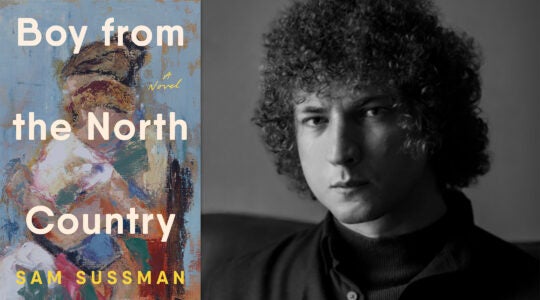
Like all card carrying members of the Jewish media, I’ve probably gone to the Abe Foxman well too many times. But don’t be too hard on us: It’s easy to understand why we go running to the ADL honcho — the guy is a big-time player who is accessible, knows how to deliver a good quote and isn’t shy about staking out strong positions. And it’s not like we’re unaware of our addiction. For years, behind the scenes, Jewish journalists have been referring to Foxman as "the pope," a self-effacing reference to our turning to him for a Jewish seal of approval or disapproval on a wide range of topics.
So I point out the following with a derisive smirk — tempered by the humility that comes with knowing that I live in a glass house full of black pots. … Check out the lead from this past weekend’s Sunday Styles article in the New York Times about the first-ever Jewish American Girl doll:
When Abraham Foxman met Rebecca Rubin, he was impressed.
“I’m surprised,” said Mr. Foxman, the director of the Anti-Defamation League, as he gazed at Rebecca, a brown-haired doll who was sitting on his desk last week, her hazel eyes locked unwaveringly onto his.
Ms. Rubin, all of 18 inches tall, is the newest historical character doll to be released by American Girl, the company in Middleton, Wis., whose products have a rabidly devoted following among the female 7- to 12-year-old set. She is a 9-year-old girl living on the Lower East Side in 1914 with her Russian-Jewish immigrant parents, siblings and a grandmother known only as Bubbie. …
Mr. Foxman, whose group fights anti-Semitism, is not easy to impress. On a windowsill of his office on Third Avenue he has a collection of wooden dolls, which he bought in Poland last October, that portray Jewish businessmen counting piles of coins.
At the request of a reporter, Mr. Foxman had read the first of six books that chronicle a year in Rebecca’s life.
“It’s not offensive. It’s sensitive,” he said. “How about that? Most of the time these things fall into stereotypes which border on the offensive.”
It is no accident that the Rebecca doll, which goes on sale May 31, did not push any of Mr. Foxman’s buttons. Every detail of her background, her appearance and whom she would be if she were actually alive, is a result of a painstaking multiyear effort by American Girl to get this character and her marketing right….
My first reaction… this is what happens when you assign a story about dolls to a male reporter (Allen Salkin). But check out this snippet from Stefanie Cohen’s report in The New York Post:
… Elan Steinberg, former director of the World Jewish Congress, raved, "This doll is bubbe-licious!"
Rabbi Marc Schneier agreed. "My only concern is that she has kosher tea parties," he joked.But some discerning shoppers say the doll’s not quite kosher.
"She’s a cute little girl, but there is nothing particularly Jewish about her," Z.C. Fishof said….
Hey, if you’re going to go the old white guy route, better to talk to the pontiff himself, rather than a pair of bishops.
And who did JTA’s Sue Fishkoff turn to for expert commentary?
… “This is our history, right here in this doll,” says author Meredith Jacobs of Rockville, Md., host of “The Modern Jewish Mom” on The Jewish Channel.
Jacobs’ family is also from Eastern Europe, and her Uncle Saul’s dreams of becoming an actor were dashed by family pressure to enter the cantorate.
Jacobs plans to buy Rebecca and her books for her 13-year-old daughter, Sophie, even though she’s just beyond the target demographic.
“I want her to read the books and talk to my parents about our history," Jacobs says. "I don’t think people who aren’t Jewish think about how big a deal it is for a mainstream doll company to make something Jewish.”
Rebecca confronts many of the same dilemmas faced by today’s American Jewish children as they navigate between tradition and modernity. In “Candlelight for Rebecca,” her teacher asks the class to make Christmas centerpieces, and Rebecca agonizes over what to tell her parents. In “Meet Rebecca,” she asks her father, an observant Jew who keeps kosher, why he opens his shoe store on Shabbat. (They need the money, he explains).
Children’s author Jacqueline Dembar Greene penned the six books about Rebecca’s life, basing some of the stories on her own family’s history. She quizzed her mother-in-law about the correct usage of certain Yiddish words and her 92-year-old father about his memories of riding the Ferris wheel at Coney Island.
Greene’s mother worked as a stitcher in a garment factory in Hartford, Conn., much like the one where Rebecca’s uncle and cousin suffered two decades earlier.
“Nothing had changed,” Greene says. “She told me about the bosses walking up and down yelling at the workers, about being locked in even though it was totally illegal. They weren’t allowed to talk or hum; they were timed when they went to the bathroom.”
Even the Christmas story came out of her own experience. Greene was in third grade in the 1950s when her teacher asked the class to make Christmas decorations.
“I brought mine home and burst into tears," she recalls. "My wise, wise mother said, ‘I bet Mrs. Crocker would love it.’ ”
Mrs. Crocker was a widowed neighbor, much like the widower Mr. Rossi in Rebecca’s book, whom the fictional character gives her own Christmas decoration.
“I gave it to her," Greene says, "and walked home feeling proud as punch.”
Click here for Sue’s full story.
JTA has documented Jewish history in real-time for over a century. Keep our journalism strong by joining us in supporting independent, award-winning reporting.





